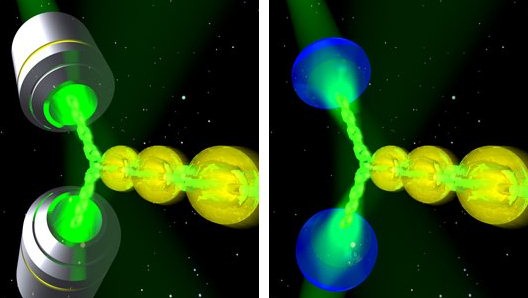Scientists turn light into a tractor beam
By David Szondy
January 28, 2013

A team led by the University of St. Andrews has turned a laser into a tractor beam that works on the microscopic level
From The Skylark of Space to Star Wars, no self-respecting science fiction spaceship would break orbit without a tractor beam on board. Weíre still a long way from locking on to errant shuttlecraft, but a team led by Dr. Tomas Cizmar, Research Fellow in the School of Medicine at the University of St. Andrews, Scotland, has turned a laser into a tractor beam that works on the microscopic level.
Tractor beams are one of those things that seem on the far edge of whatís possible. The idea of a beam of energy streaming out that pulls things in is counter-intuitive, but scientists have been developing things that work like tractor beams since the 1960s and light manipulation has been tried since the 1970s.
In recent years, several ways of imitating the fictional tractor beam have been investigated, including optical vortices, optical tweezers, Bessel beams and optical pipelines. Developed in association with the Institute of Scientific Instruments (ISI) in the Czech Republic, the St. Andrews team claims that its tractor beam is different in that itís the first time that a light beam has been made to draw objects toward the light source.
Though the tractor beam only works under very specific conditions on a microscopic scale, it involves a principle thatís been known for centuries, since Johannes Kepler first deduced that it was the pressure of light that pushed comet tails outward from the sun. This light pressure has already been harnessed for solar sails and attitude controls for satellites, but the St. Andrews team has found a way to turn this pressure into a negative force.
This negative force is produced in a laboratory set up by a mixture of very specific properties of light and the object being moved. In the St. Andrews experiment, a Gaussian beam (a light beam where the profile is described by a Gaussian mathematical formula) is generated by a VERDI V5 laser. This beam is directed through a lens and then passes through a suspension of dielectric spheres set between two coverslips.
The bottom slip is a half-silvered reflecting mirror that reflects part of the beam back to the source. The incoming and reflecting beams interfere with one another and produce a standing wave. Based on the properties of the spheres and their location, the standing wave shapes in such a way that the light force pushes the spheres back toward the laser source.
Putting it simply, the standing wave at a particular spot near the light source interacts with spheres of a particular size and mass in such a way that the light waves push in the wrong direction. Itís a bit like a dinghy moored at a pier where the current is moving away from the pier, but produces eddies that push the dinghy back into the pier.
The team sees a number of applications for the tractor beam in biomedical photonics and other disciplines, such as the simple and inexpensive optical sorting of macromolecules, organelles or cells.
The findings of the team were published in Nature Photonics.
Source: University of St. Andrews
Copyright © gizmag 2003 - 2013 To subscribe or visit go to: http://www.gizmag.com
